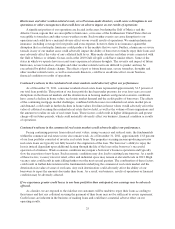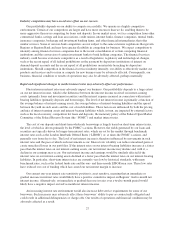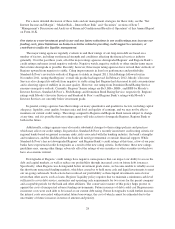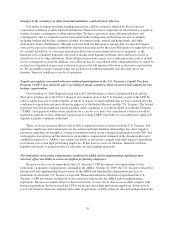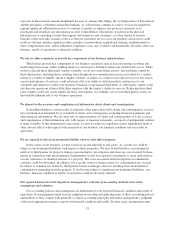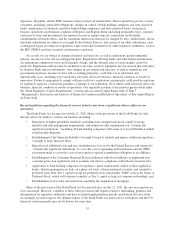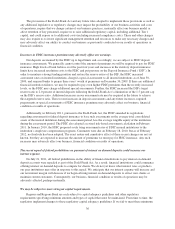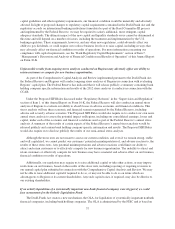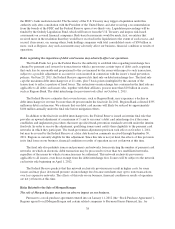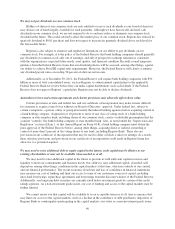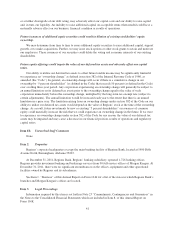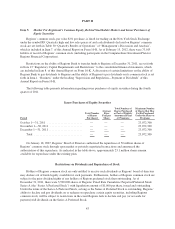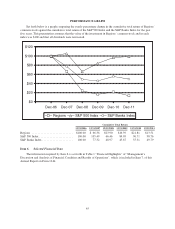Regions Bank 2011 Annual Report Download - page 59
Download and view the complete annual report
Please find page 59 of the 2011 Regions Bank annual report below. You can navigate through the pages in the report by either clicking on the pages listed below, or by using the keyword search tool below to find specific information within the annual report.depositors, the public and the FDIC insurance fund, and not our shareholders. These regulations govern a variety
of matters, including certain debt obligations, changes in control of bank holding companies and state-chartered
banks, maintenance of adequate capital by bank holding companies and state-chartered banks, and general
business operations and financial condition of Regions and Regions Bank (including permissible types, amounts
and terms of loans and investments, the amount of reserves against deposits, restrictions on dividends,
establishment of branch offices, and the maximum interest rate that may be charged by law). Additionally, all our
non-bank subsidiaries are subject to oversight by the Federal Reserve, and certain of our other subsidiaries, such
as Morgan Keegan, are subject to regulation, supervision and examination by other regulatory authorities, such as
the SEC, FINRA and state securities and insurance regulators.
As a result, we are subject to changes in federal and state law, as well as regulations and governmental
policies, income tax laws and accounting principles. Regulations affecting banks and other financial institutions
are undergoing continuous review and frequently change, and the ultimate effect of such changes cannot be
predicted. Regulations and laws may be modified at any time, and new legislation may be enacted that will affect
us, Regions Bank and our subsidiaries. Any changes in any federal and state law, as well as regulations and
governmental policies, income tax laws and accounting principles, could affect us in substantial and
unpredictable ways, including ways which may adversely affect our business, financial condition or results of
operations. Failure to appropriately comply with any such laws, regulations or principles could result in sanctions
by regulatory agencies, civil money penalties or damage to our reputation, all of which could adversely affect our
business, financial condition or results of operations. Our regulatory position is discussed in greater detail under
the “Bank Regulatory Capital Requirements” section and associated Capital Ratios table of Item 7.
“Management’s Discussion and Analysis of Financial Condition and Results of Operation” of this Annual Report
on Form 10-K.
Recent legislation regarding the financial services industry may have a significant adverse effect on our
operations.
The Dodd-Frank Act became law on July 21, 2010. Many of the provisions of the Dodd-Frank Act will
directly affect our ability to conduct our business including:
• Imposition of higher prudential standards, including more stringent risk-based capital, leverage,
liquidity and risk-management requirements, and numerous other requirements on “systemically
significant institutions,” including all bank holding companies with assets of at least $50 billion (which
would include Regions);
• Establishment of the Financial Stability Oversight Council to identify and impose additional regulatory
oversight of large financial firms;
• Imposition of additional costs and fees, including fees to be set by the Federal Reserve and charged to
“systemically significant institutions” to cover the cost of regulating such institutions and any FDIC
assessment made to cover the costs of any regular or special examination of Regions or its affiliates;
• Establishment of the Consumer Financial Protection Bureau with broad authority to implement new
consumer protection regulations and to examine and enforce compliance with federal consumer laws;
• Application to bank holding companies of regulatory capital requirements similar to those applied to
banks, which requirements exclude, on a phase-out basis, all trust preferred securities and cumulative
preferred stock from Tier 1 capital (except for preferred stock issued under TARP, such as the Series A
Preferred Stock, which will continue to qualify as Tier 1 capital as long as it remains outstanding); and
• Establishment of new rules and restrictions regarding the origination of mortgages.
Many of the provisions of the Dodd-Frank Act became effective on July 21, 2011, the one-year anniversary
of its enactment. However, a number of these other provisions still require extensive rulemaking, guidance and
interpretation by regulatory authorities and have extended implementation periods and delayed effective dates.
Accordingly, in some respects, the ultimate impact of the Dodd-Frank Act and its effect on Regions and the U.S.
financial system generally may not be known for some time.
35


